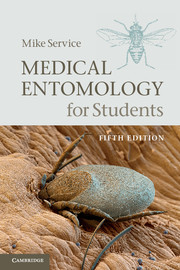Book contents
- Frontmatter
- Contents
- Preface to the first edition
- Preface to the second edition
- Preface to the third edition
- Preface to the fourth edition
- Preface to the fifth edition
- Acknowledgements
- 1 Introduction to mosquitoes (Culicidae)
- 2 Anopheline mosquitoes (Anophelinae)
- 3 Culicine mosquitoes (Culicinae)
- 4 Black flies (Simuliidae)
- 5 Phlebotomine sand flies (Phlebotominae)
- 6 Biting midges (Ceratopogonidae)
- 7 Horse flies (Tabanidae)
- 8 Tsetse flies (Glossinidae)
- 9 House flies and stable flies (Muscidae) and latrine flies (Fanniidae)
- 10 Flies and myiasis
- 11 Fleas (Siphonaptera)
- 12 Sucking lice (Anoplura)
- 13 Bedbugs (Cimicidae)
- 14 Triatomine bugs (Triatominae)
- 15 Cockroaches (Blattaria)
- 16 Soft ticks (Argasidae)
- 17 Hard ticks (Ixodidae)
- 18 Scabies mites (Sarcoptidae)
- 19 Scrub typhus mites (Trombiculidae)
- 20 Miscellaneous mites
- Appendix Names of some chemicals and microbials used in vector control (with common trade names in parentheses)
- Glossary of common terms relevant to medical entomology
- Select bibliography
- Index
- Plate section
- References
9 - House flies and stable flies (Muscidae) and latrine flies (Fanniidae)
Published online by Cambridge University Press: 05 June 2012
- Frontmatter
- Contents
- Preface to the first edition
- Preface to the second edition
- Preface to the third edition
- Preface to the fourth edition
- Preface to the fifth edition
- Acknowledgements
- 1 Introduction to mosquitoes (Culicidae)
- 2 Anopheline mosquitoes (Anophelinae)
- 3 Culicine mosquitoes (Culicinae)
- 4 Black flies (Simuliidae)
- 5 Phlebotomine sand flies (Phlebotominae)
- 6 Biting midges (Ceratopogonidae)
- 7 Horse flies (Tabanidae)
- 8 Tsetse flies (Glossinidae)
- 9 House flies and stable flies (Muscidae) and latrine flies (Fanniidae)
- 10 Flies and myiasis
- 11 Fleas (Siphonaptera)
- 12 Sucking lice (Anoplura)
- 13 Bedbugs (Cimicidae)
- 14 Triatomine bugs (Triatominae)
- 15 Cockroaches (Blattaria)
- 16 Soft ticks (Argasidae)
- 17 Hard ticks (Ixodidae)
- 18 Scabies mites (Sarcoptidae)
- 19 Scrub typhus mites (Trombiculidae)
- 20 Miscellaneous mites
- Appendix Names of some chemicals and microbials used in vector control (with common trade names in parentheses)
- Glossary of common terms relevant to medical entomology
- Select bibliography
- Index
- Plate section
- References
Summary
There are some 18 000 species of true flies (sometimes called calyptrate Diptera), including medically important species in the families Glossinidae (Chapter 8), and the Muscidae and Fanniidae, which are described in this chapter.
The Muscidae contains about 4200 species of flies in 190 genera. The medically most important are the common house fly (Musca domestica), the greater house fly (Muscina stabulans) and the stable fly (Stomoxys calcitrans), all having a more or less worldwide distribution. House flies can be vectors of helminths, faecal bacteria, protozoans and viruses, resulting in the spread of enteric diseases (e.g. dysenteries and typhoids). The stable fly is a biting pest.
The family Fanniidae comprises about 280 species in four genera, but only species in the genus Fannia, such as F. canicularis (lesser house fly) and F. scalaris (latrine fly), are of medical importance, and like house flies they can transmit various pathogens to humans.
The common house fly (Musca domestica)
External morphology
There are about 70 species of flies in the genus Musca. The most common is M. domestica, the house fly, which is almost worldwide but is least common in Africa, where it is largely replaced by two subspecies (M. domestica curviforceps and M. domestica calleva). Other important species are (1) the bazaar fly (Musca sorbens), which can be a great nuisance in Africa, Asia and the Pacific, (2) the notoriously troublesome bush fly (M. vetustissima) of Australia and (3) the face fly (M. autumnalis), which is a pest in both the Old and New Worlds. The appearance and biology of these Musca species are very similar. The morphology and biology of the house fly (M. domestica) are described here.
- Type
- Chapter
- Information
- Medical Entomology for Students , pp. 139 - 156Publisher: Cambridge University PressPrint publication year: 2012
References
- 1
- Cited by



